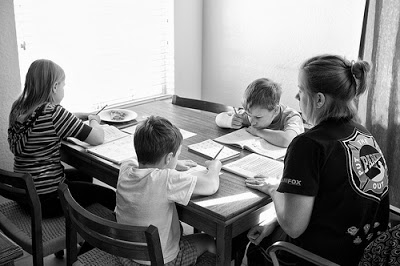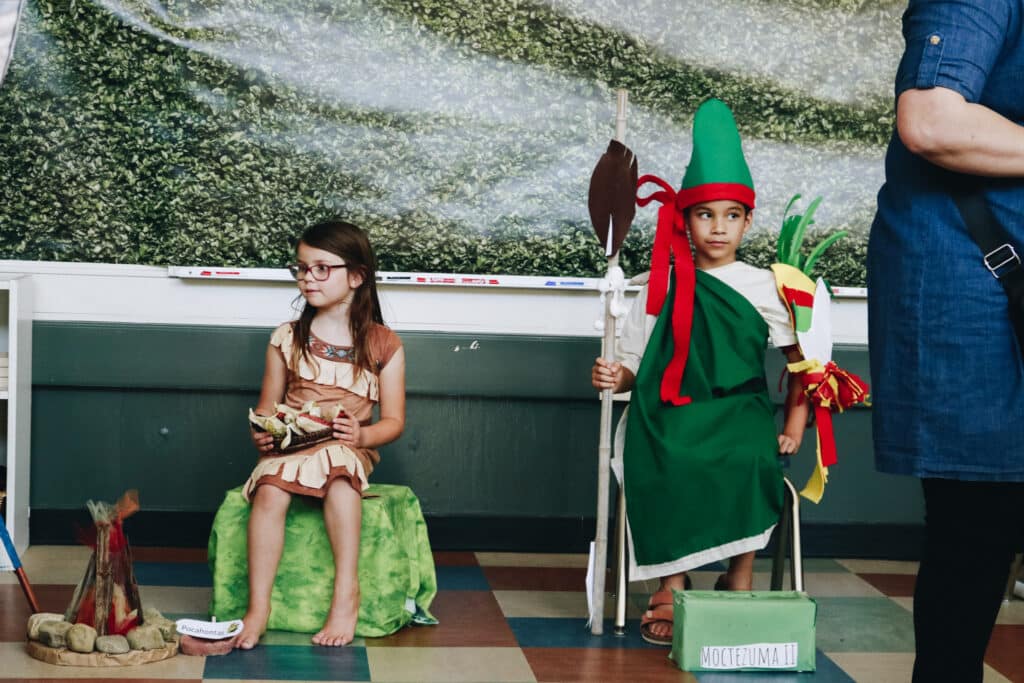{source}
If you are working with more than one student on your home days, you’ve probably experienced how tricky it can be to complete the assignments and reading and home subjects, all in a reasonable amount of time while connecting with your kids and enjoying the process, right? If you’re new to home education, or you’ve just added another student, or are in need of some new ideas for home educating multiple children, you’re not alone! While our goal on home days isn’t perfection, there are usually some tips we can try to help the day run more smoothly. Here are a few to get the ball rolling, including some from SLOCA parents, and we hope you will chime in with what works for you!
– Workboxes, or some other system that clearly lays out each child’s work for the day, can be a big help and keep everyone moving forward even if mom (or dad) is working with someone else. Lindsey Cheney, Track A mother of Gracie (Intermediate), Lily (Primary), and Silas (Kindergarten), claims workboxes are her biggest tip to share with other parents. She tries to set up the boxes so that two kids are working independently while she works with the other child. She also places toys in some of her youngest child’s boxes so that he can have fun while waiting for mom, but she gets to decide what he plays with rather than letting him wander off to another room to make a mess.
– Try to figure out what time of day each child is at their most alert and ready to learn, and plan your most difficult subject with them at that time. For example, I (Jenny) have one child who needs to do math first thing in the morning, but another child isn’t really awake and cooperative until almost noon. I stopped trying to teach math to that child first thing, but let her start her day with independent reading, copywork, and spelling, which are easier tasks.
– Have a few different spots where children can work, so that if one needs quiet and the others need interaction, you aren’t all in each other’s space. This doesn’t mean you need multiple desks. You can have one main desk or table area, but give another child the option to use a clipboard or lapdesk on the floor or on a bed, or send independent readers to the living room couch, etc. It might be helpful to utilize the hallway floor for a student who needs to be free from toys and visual distractions.
– Take reading outside where younger siblings can play while the older ones sit and listen, maybe sketching while you read. You’ll all appreciate the change of scenery, and get some vitamin D!
– Let an older child read to a younger, or help them with simple tasks.
– For older students (in the logic and rhetoric stages), training them to work independently is obviously a huge help, and the ultimate goal. Although we still want to be involved as parents, older students don’t need us right next to them all day. Many kids want to be more independent as they get older, so the key is to work out systems for reviewing their work and having them check in with you to make sure they’re completing their assignments. One idea is to set up “office hours” for these students, much like a college professor would.
– Tamzin Ritter is a Track A mother of three SLOCA students: Mia (Intermediate), Sienna, (Intermediate), and Fiona (Primary). She has a great idea to share about home educating multiple children. She has a few centers set up in her home that she rotates her three girls through. One is a listening center where the kids can read along with audio books, keeping them engaged and quiet. She also has an art project center set up each day, and a poster center. These centers give each girl independent work time, while allowing Tamzin quality one-on-one instruction time with each student.
– Tamzin Ritter is a Track A mother of three SLOCA students: Mia (Intermediate), Sienna, (Intermediate), and Fiona (Primary). She has a great idea to share about home educating multiple children. She has a few centers set up in her home that she rotates her three girls through. One is a listening center where the kids can read along with audio books, keeping them engaged and quiet. She also has an art project center set up each day, and a poster center. These centers give each girl independent work time, while allowing Tamzin quality one-on-one instruction time with each student.
– Penny Malley, Track B Intermediate teacher and mother of four SLOCA students, definitely knows a thing or two about homeschooling more than one child! She is helping Katie (UMS), Tyler (LMS), TJ (Primary), and Abby (Kindergarten) on home days, and has a few tips to share with us about how she makes it work:
- Workboxes! I spend a few minutes the night before getting everything ready for the next home day, and that day goes so much more smoothly than if I’m scrambling to check grids and see “what’s next”.
- Tyler likes to start his work earlier in the morning and be done sooner, so he and I do math together at 8:30, and the others join us at the homeschooling table (i.e. dining room table that’s no longer used for actually dining) at 9:00.
- I stagger the workboxes that contain activities that need my assistance, so that everyone keeps busy working while I’m helping one particular child. This works in THEORY; it is a work in progress, for sure! I start math with TJ at 9:00, so I give Abby a couple of independent activities to start her day, like her own journal or a dot-to-dot or cut-and-paste activity. When I’m done with TJ’s math, I start Abby’s math with her. TJ moves on to handwriting and spelling, which are independent activities for him.
- I read all history and literature to everyone. It’s usually at snack-time, so as soon as I say, “Let’s meet in the front room!”, everyone scrambles to the kitchen to grab something to munch on while I read. Katie usually takes out her knitting or friendship bracelets to work on, as well. I have found that she actually listens better if her hands are busy. I start with the youngest history readings, in this case, Primary. As soon as TJ’s readings are done, I send him back to work on his narrative or draw a picture of what he learned. Then I focus on the older kids. They hear a simplified or condensed version of history thanks to the Primary readings, and they comprehend more of their own readings. It’s a win-win!
- Since we’re all reading Treasure Island right now, I’ve chosen to only read the middle-school version aloud. TJ reads the Classic Starts version on his own, and we talk about it after he’s finished the day’s reading. This saves my voice (yay!) and gives TJ and Abby the chance to hear the original story that’s full of rich language and beautiful illustrations.
What a great list of ideas – thank you ladies, for sharing what works for you! We know there are other useful tips out there and we’d love to hear from our community about what helps you with multiple children at home too. We can all benefit from the ideas of others, so please comment below and join the discussion!
SLO Classical Academy is not affiliated with any of the above mentioned businesses.












